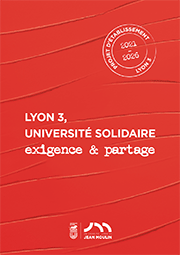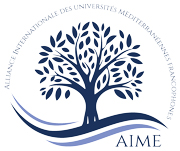AccueilRechercheProgrammes et productions scientifiquesThèsesThèses soutenuesThèses soutenues - 2006-2021Thèses soutenues - 2012
-
Partager cette page
- Recherche,
WAWRZYNIAK Vincent
Etude multi-échelle de la température de surface des cours d’eau par imagerie infrarouge thermique : exemples dans le bassin du Rh?ne
Publié le 4 janvier 2013 – Mis à jour le 7 janvier 2013
Thèse en Géographie aménagement soutenue le 12 décembre 2012
Dans un contexte de changement climatique, la compréhension du régime thermique des cours d’eau est un enjeu important. En mesurant le rayonnement dans le spectre électromagnétique de l’infrarouge thermique (IRT : 0,4-14?m), la télédétection IRT offre la possibilité d’obtenir une cartographie de la température de surface à différentes échelles spatiales. L’approche multi-échelle est ainsi le fil directeur de ce travail.
Dans le premier temps, nous utilisons des images satellites Landsat ETM+ pour caractériser les structures thermiques longitudinales et temporelles d’un grand continuum fluvial : le Rh?ne fran?ais (500 km). Une méthode automatique supprimant les pixels contaminés par les entités exondées, est développée, améliorant ainsi la précision des données. Les images nous permettent de comprendre les effets thermiques des affluents et des centrales nucléaires. L’Isère est la principale source d’eau froide, alors que les centrales nucléaires du Bugey, de Saint-Alban et de Tricastin réchauffent le fleuve. Nous mettons en évidence des anomalies thermiques au niveau des aménagements hydroélectriques. Par rapport aux canaux, les Rh?ne court-circuités (RCC) sont plus sensibles aux conditions extérieures du fait de leur géométrie et de leurs conditions hydrauliques.
Dans un second temps, les travaux se focalisent sur un tron?on plus court (50 km) : l’Ain dans sa basse vallée où quatre campagnes IRT aéroportées sont réalisées. Nous développons une méthode statistique permettant de calculer l’incertitude de mesure associée à la construction des profils longitudinaux de température de l’eau. Les artefacts des vraies tendances longitudinales sont ainsi différenciés. Pour comprendre ces tendances, un modèle 1D (thermo-hydraulique) est mis en place sur 21 kilomètres. Il considère les flux de chaleur à l’interface eau-air et les propriétés géométriques ainsi qu’hydrauliques de la rivière. Les arrivées phréatiques associées aux bras morts et aux suintements latéraux sont identifiées sur les images thermiques et intégrées au modèle. Ces arrivées phréatiques peuvent refroidir l’Ain de 0,6°C en été lorsqu’elles représentent 15,7% du débit total.
Une échelle plus fine est explorée enfin. Le travail porte cette fois sur neuf tron?ons en tresses (1 km) pour lesquels des images IRT à très haute résolution spatiale sont acquises. En caractérisant les distributions spatiales de la température, nous identifions deux types de tron?ons. Le premier montre une très faible variabilité thermique spatiale tout au long de la journée. Les cours d’eau de ce type ont bien souvent un régime hydrologique proglaciaire avec des débits estivaux élevés, ce qui tend à homogénéiser la température. Le second type présente une hétérogénéité thermique élevée. La température des chenaux courants varie avec la température de l'air. En revanche, la température des chenaux alimentés par des eaux souterraines est relativement constante au cours de la journée. Nous proposons une méthode ne nécessitant pas d’images IRT pour identifier les tron?ons montrant une variabilité thermique élevée.
? travers ce travail, nous montrons qu’il est nécessaire de coupler les approches spatiales et temporelles pour comprendre la température des cours d’eau. Longtemps, les mesures ont été effectuées avec des thermomètres. L’aspect spatial a ainsi souvent été ignoré. La télédétection IRT a permis de mieux appréhender les structures spatiales de température. Toutefois, pour comprendre ces dernières il est indispensable de considérer les changements temporels de température. Il est également nécessaire d’intégrer une approche plus physique permettant de simuler différentes situations pour évaluer l’importance des différents facteurs affectant la température.
In a context of global warming, understanding the thermal regime of rivers is a key issue. By measuring the radiation in the electromagnetic spectrum of thermal infrared (TIR: 0.4-14?m), TIR remote sensing offers the possibility of obtaining surface temperature maps at multiple scales. The multi-scale approach is thus the guiding principle of this work.
First we use satellite thermal infrared images from Landsat ETM+ to investigate longitudinal and temporal variations in the thermal patterns of a large river continuum, the French Rh?ne (500 km). An automated water extraction technique is developed to remove pixels contaminated by terrestrial surfaces. This method improves the accuracy of our data. The images allow us to understand the thermal effects of tributaries and nuclear power plants: the Isère is the main source of cold water while the Bugey, Saint-Alban and Tricastin nuclear power plants warm the river. We show temperature differences within the largest hydroelectric bypass facilities between the bypass section and the canal. The factors responsible for these differences are the length and minimum flow of the bypass section as well as tributaries coming into this reach.
Second, we focus on a shorter river (50 km): the lower Ain in France where four airborne TIR surveys are performed. Based on a statistical analysis of temperature differences between overlapping images we calculate the measurement uncertainty associated with TIR derived profiles. This uncertainty allows for the discrimination between artifacts and real longitudinal thermal trends. To understand these trends, we use a 1D determinist model which predicts water temperature at an hourly time step along a 21 km reach. The model considers heat fluxes at the water-air interface as well as the geometrical and hydraulic characteristics of the river. Based on TIR images, groundwater inputs associated with backwaters and lateral seepages are identified. They are inserted into the temperature model. These groundwater inputs can mitigate high water temperatures during the summer by cooling the river up to -0.6°C when they represent 15.7% of the total discharge.
A finer scale is finally explored. The work focuses on nine braided reaches located in the French Alps (1 km) where very high spatial resolution TIR images are acquired. By characterizing the spatial distributions of water temperature, we identify two types of reaches. The first type shows a very low thermal spatial variability throughout the day. Rivers of this type often have a proglacial hydrological regime with high summer flows, which tends to homogenize the temperature. The second type exhibits a higher thermal variability with changes during the day. The temperature of flowing channels changes during the daytime according to the air temperature. In contrast, the temperature of groundwater-fed channels exhibits smaller changes which creates thermal variability over space and time. We propose a method which does not require TIR images in order to identify reaches showing high thermal variability.
Through this work, we show that it is essential to combine both spatial and temporal approaches to understand river temperature. Thermometers have been used for many years. Thus, the spatial aspect has often been ignored. TIR remote sensing has allowed a better characterization of spatial thermal patterns. However, to understand these patters it is necessary to consider temporal changes of water temperature. It is also necessary to integrate a more physical approach in order to simulate different scenarios and to assess the importance of the different factors affecting water temperature.
Mots-clés : Structures thermiques des cours d’eau ; étude multi-scalaire ; effets thermiques des affluents, aménagements anthropiques et apports phréatiques/hyporhéiques ; télédétection infrarouge thermique (IRT) multi-plateforme ; modélisations statistiques et déterministes ; Rh?ne, Ain et rivières en tresses du bassin Rhodanien.
Key words : River thermal patterns; multi-scale study; effects of tributaries, human facilities and groundwater inputs; multi-platform thermal infrared (TIR) remote sensing; statistical and determinist modeling; Rh?ne, Ain and braided reaches (South East France).
Directeur de thèse : Pascal ALLEMAND
Hervé PIEGAY
Membres du jury :
Florentina MOATAR, Professeur, Université Fran?ois Rabelais, Tour
Laurence HUBERT-MOY, Professeur, Université de Rennes 2
Stanley V. GREGORY, Professeur, Orega State University
Vicen? ACUNA, Chercheur, Institut Català de Recerca de l’Aigua
Alain POIREL, Chercheur, EDF DTG, Grenoble
Pascal ALLEMAND, Professeur, Université Claude Bernard Lyon 1
Hervé PIEGAY, Directeur de recherche, CNRS Lyon
Président du jury : Laurence HUBERT-MOY
Mention : Très honorable avec les félicitations du jury
Equipe d'accueil : UMR 5600
Dans le premier temps, nous utilisons des images satellites Landsat ETM+ pour caractériser les structures thermiques longitudinales et temporelles d’un grand continuum fluvial : le Rh?ne fran?ais (500 km). Une méthode automatique supprimant les pixels contaminés par les entités exondées, est développée, améliorant ainsi la précision des données. Les images nous permettent de comprendre les effets thermiques des affluents et des centrales nucléaires. L’Isère est la principale source d’eau froide, alors que les centrales nucléaires du Bugey, de Saint-Alban et de Tricastin réchauffent le fleuve. Nous mettons en évidence des anomalies thermiques au niveau des aménagements hydroélectriques. Par rapport aux canaux, les Rh?ne court-circuités (RCC) sont plus sensibles aux conditions extérieures du fait de leur géométrie et de leurs conditions hydrauliques.
Dans un second temps, les travaux se focalisent sur un tron?on plus court (50 km) : l’Ain dans sa basse vallée où quatre campagnes IRT aéroportées sont réalisées. Nous développons une méthode statistique permettant de calculer l’incertitude de mesure associée à la construction des profils longitudinaux de température de l’eau. Les artefacts des vraies tendances longitudinales sont ainsi différenciés. Pour comprendre ces tendances, un modèle 1D (thermo-hydraulique) est mis en place sur 21 kilomètres. Il considère les flux de chaleur à l’interface eau-air et les propriétés géométriques ainsi qu’hydrauliques de la rivière. Les arrivées phréatiques associées aux bras morts et aux suintements latéraux sont identifiées sur les images thermiques et intégrées au modèle. Ces arrivées phréatiques peuvent refroidir l’Ain de 0,6°C en été lorsqu’elles représentent 15,7% du débit total.
Une échelle plus fine est explorée enfin. Le travail porte cette fois sur neuf tron?ons en tresses (1 km) pour lesquels des images IRT à très haute résolution spatiale sont acquises. En caractérisant les distributions spatiales de la température, nous identifions deux types de tron?ons. Le premier montre une très faible variabilité thermique spatiale tout au long de la journée. Les cours d’eau de ce type ont bien souvent un régime hydrologique proglaciaire avec des débits estivaux élevés, ce qui tend à homogénéiser la température. Le second type présente une hétérogénéité thermique élevée. La température des chenaux courants varie avec la température de l'air. En revanche, la température des chenaux alimentés par des eaux souterraines est relativement constante au cours de la journée. Nous proposons une méthode ne nécessitant pas d’images IRT pour identifier les tron?ons montrant une variabilité thermique élevée.
? travers ce travail, nous montrons qu’il est nécessaire de coupler les approches spatiales et temporelles pour comprendre la température des cours d’eau. Longtemps, les mesures ont été effectuées avec des thermomètres. L’aspect spatial a ainsi souvent été ignoré. La télédétection IRT a permis de mieux appréhender les structures spatiales de température. Toutefois, pour comprendre ces dernières il est indispensable de considérer les changements temporels de température. Il est également nécessaire d’intégrer une approche plus physique permettant de simuler différentes situations pour évaluer l’importance des différents facteurs affectant la température.
In a context of global warming, understanding the thermal regime of rivers is a key issue. By measuring the radiation in the electromagnetic spectrum of thermal infrared (TIR: 0.4-14?m), TIR remote sensing offers the possibility of obtaining surface temperature maps at multiple scales. The multi-scale approach is thus the guiding principle of this work.
First we use satellite thermal infrared images from Landsat ETM+ to investigate longitudinal and temporal variations in the thermal patterns of a large river continuum, the French Rh?ne (500 km). An automated water extraction technique is developed to remove pixels contaminated by terrestrial surfaces. This method improves the accuracy of our data. The images allow us to understand the thermal effects of tributaries and nuclear power plants: the Isère is the main source of cold water while the Bugey, Saint-Alban and Tricastin nuclear power plants warm the river. We show temperature differences within the largest hydroelectric bypass facilities between the bypass section and the canal. The factors responsible for these differences are the length and minimum flow of the bypass section as well as tributaries coming into this reach.
Second, we focus on a shorter river (50 km): the lower Ain in France where four airborne TIR surveys are performed. Based on a statistical analysis of temperature differences between overlapping images we calculate the measurement uncertainty associated with TIR derived profiles. This uncertainty allows for the discrimination between artifacts and real longitudinal thermal trends. To understand these trends, we use a 1D determinist model which predicts water temperature at an hourly time step along a 21 km reach. The model considers heat fluxes at the water-air interface as well as the geometrical and hydraulic characteristics of the river. Based on TIR images, groundwater inputs associated with backwaters and lateral seepages are identified. They are inserted into the temperature model. These groundwater inputs can mitigate high water temperatures during the summer by cooling the river up to -0.6°C when they represent 15.7% of the total discharge.
A finer scale is finally explored. The work focuses on nine braided reaches located in the French Alps (1 km) where very high spatial resolution TIR images are acquired. By characterizing the spatial distributions of water temperature, we identify two types of reaches. The first type shows a very low thermal spatial variability throughout the day. Rivers of this type often have a proglacial hydrological regime with high summer flows, which tends to homogenize the temperature. The second type exhibits a higher thermal variability with changes during the day. The temperature of flowing channels changes during the daytime according to the air temperature. In contrast, the temperature of groundwater-fed channels exhibits smaller changes which creates thermal variability over space and time. We propose a method which does not require TIR images in order to identify reaches showing high thermal variability.
Through this work, we show that it is essential to combine both spatial and temporal approaches to understand river temperature. Thermometers have been used for many years. Thus, the spatial aspect has often been ignored. TIR remote sensing has allowed a better characterization of spatial thermal patterns. However, to understand these patters it is necessary to consider temporal changes of water temperature. It is also necessary to integrate a more physical approach in order to simulate different scenarios and to assess the importance of the different factors affecting water temperature.
Mots-clés : Structures thermiques des cours d’eau ; étude multi-scalaire ; effets thermiques des affluents, aménagements anthropiques et apports phréatiques/hyporhéiques ; télédétection infrarouge thermique (IRT) multi-plateforme ; modélisations statistiques et déterministes ; Rh?ne, Ain et rivières en tresses du bassin Rhodanien.
Key words : River thermal patterns; multi-scale study; effects of tributaries, human facilities and groundwater inputs; multi-platform thermal infrared (TIR) remote sensing; statistical and determinist modeling; Rh?ne, Ain and braided reaches (South East France).
Directeur de thèse : Pascal ALLEMAND
Hervé PIEGAY
Membres du jury :
Florentina MOATAR, Professeur, Université Fran?ois Rabelais, Tour
Laurence HUBERT-MOY, Professeur, Université de Rennes 2
Stanley V. GREGORY, Professeur, Orega State University
Vicen? ACUNA, Chercheur, Institut Català de Recerca de l’Aigua
Alain POIREL, Chercheur, EDF DTG, Grenoble
Pascal ALLEMAND, Professeur, Université Claude Bernard Lyon 1
Hervé PIEGAY, Directeur de recherche, CNRS Lyon
Président du jury : Laurence HUBERT-MOY
Mention : Très honorable avec les félicitations du jury
Equipe d'accueil : UMR 5600
Documentation
Mise à jour : 7 janvier 2013







